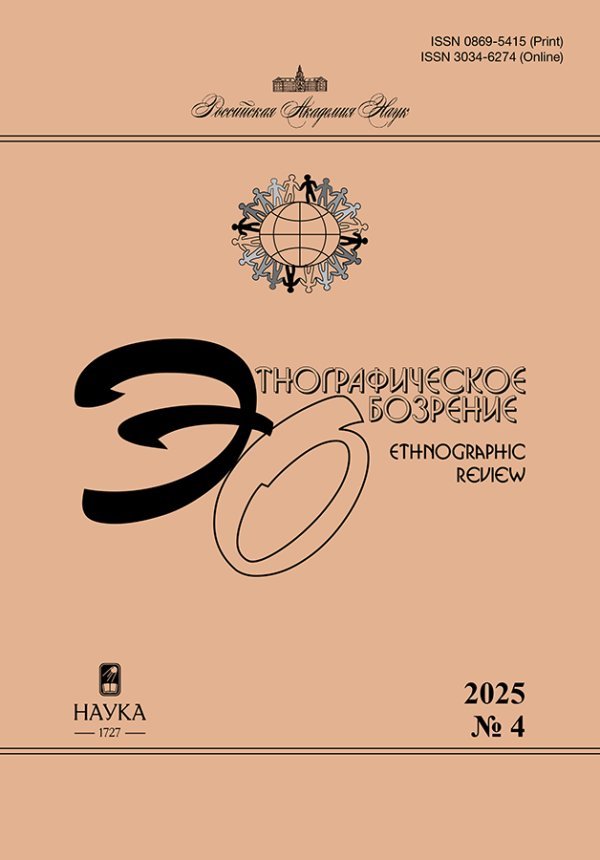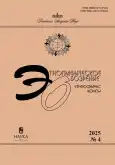Kudel-Drem: An Interpretation of the Red Hill Rituals among the Don Cossacks
- Authors: Ryblova M.A.1,2
-
Affiliations:
- Federal Research Centre The Southern Scientific Centre, Russian Academy of Sciences
- Volgograd State University
- Issue: No 4 (2025)
- Pages: 164-184
- Section: Research Articles
- URL: https://stomuniver.ru/0869-5415/article/view/697021
- DOI: https://doi.org/10.31857/S0869541525040118
- ID: 697021
Cite item
Abstract
The article provides a general description of the rituals of the Red Hill among the Don Cossacks and a detailed reconstruction of the Kudel ritual, recorded by the author in the village of Lukovskaya, Nekhaevsky District, Volgograd Region, in 2008. This ritual was performed here on the Red Hill until the mid-1980s. Based on her field materials, the testimonies of other folklorists, and previously published texts of round dance songs related to spinning and weaving, the author provides an interpretation of this ritual, identifies the main features of the collective image of Kudel-Drem, and shows its connection with the other world and the souls of deceased girls of marriageable age. In this case, we are talking about a specific category of girls who, during their lifetime, had committed “wrong” actions, such as neglecting their feminine crafts and engaging in premarital relationships. According to popular beliefs, the unspent life force (share) of these deceased individuals should be included in the total life force/share of the girls of marriageable age in a particular village. In addition, the Kudel ritual served as a socializing/educational function, symbolically marking the transition between different time periods and associated collective activities among young people.
About the authors
M. A. Ryblova
Federal Research Centre The Southern Scientific Centre, Russian Academy of Sciences; Volgograd State University
Author for correspondence.
Email: ryblova@volsu.ru
ORCID iD: 0000-0003-1451-2579
д. и. н., доцент, главный научный сотрудник 41 Chekhov Ave., Rostov-on-Don, 344006, Russia; 100 Prospect Universitetsky, Volgograd, 400062, Russia
References
- Baiburin, A.K. 1993. Ritual v traditsionnoi kul’ture. Strukturno-semanticheskii analiz vostochnoslavianskikh obriadov [Ritual in Traditional Culture: Structural and Semantic Analysis of East Slavic Rituals]. St. Petersburg: Nauka.
- Bernshtam, T.A. 1999. “Khitro-mudro rukodel’itse” (vyshivanie-shit’e v simvolizme devich’ego sovershennoletiia u vostochnykh slavian) [“Cunningly-Wisely Needlework” (Embroidery-Sewing in the Symbolism of the Maiden Coming of Age among the Eastern Slavs]. In Zhenshchina i veshchestvennyi mir kul’tury u narodov Evropy i Rossii [Women and the Material World of Culture in Europe and Russia], edited by T.A. Bernshtam, 191–249. St. Petersburg: Peterburgskoe vostokovedenie.
- Bernshtam, Т.А. 1986. K rekonstruktsii nekotorykh russkikh perekhodnykh obriadov sovershennoletiia [Towards the Reconstruction of Some Russian Transitional Rites of Coming of Age]. Sovetskaia etnografiia 6: 24–35.
- Biteriakovа, E.V. 2020. Ob odnom khorovode stanitsy Lukovskoi v zapisiakh nachala i kontsa XX veka [About One Round Dance of the Village of Lukovskaya in the Records of the Beginning and End of the 20th Century]. Traditsionnaia kul’tura 1: 36–51.
- Filippova, I.A. 2009. O nekotorykh mifopoeticheskikh dominantakh vesennego kalendaria kazach’ikh poselenii yuga Cheliabinskoi oblasti [About Some Mythopoetic Dominants of the Spring Calendar of Cossack Settlements in the South of the Chelyabinsk Region]. Problemy istorii, filologii, kul’tury 1 (23): 457–462.
- Kharuzin, M.N. 1885. Svedeniia o kazatskikh obshchinakh na Donu. Materialy dlia obychnogo prava [Information about the Cossack Communities on the Don: Materials for Customary Law]. Moscow: Tipografiia M.P. Shchepkina.
- Morozov, I.A. 1998. Zhenit’ba dobra molodtsa. Proiskhozhdenie i tipologiia traditsionnykh molodezhnykh razvlechenii s simvolikoi “svad’by”/“zhenit’by [The Marriage of a Good Fellow: The Origin and Typology of Traditional Youth Entertainment with the Symbolism of “Wedding”/“marriage”]. Moscow: Labirint.
- Palgov, S.Y., and V.A. Shilkin. 2020. Kalendarnye obriady Volzhskogo Ponizov’ia i Podon’ia (po materialam fol’klornykh ekspeditsii) [Calendar Rites of the Volga Lowlands and the Don Region (Based on Materials from Folklore Expeditions)]. Volgograd.
- Ryblova, M.A. 2001. Donskie verkhovye i nizovye kazaki: k voprosu o lokalizatsii gruppy [Don Riding and Grassroots Cossacks: On the Issue of Localization of the Group]. Vestnik VolGU: Istoriia. Regionovedenie. Mezhdunarodnye otnosheniia 6: 57–69.
- Ryblova, M.A. 2010. Kalendarnye prazdniki donskikh kazakov [Calendar Holidays of Don Cossacks]. Volgograd: Izdatel’stvo VolGU.
- Ryblova, M.A. 2023. Personazhi donskikh kazach’ikh khorovodov: poiski sviazei s inomir’em [Characters of Don Cossack Round Dances: Searching for Connections with a Foreign Country]. In Sovremennoe sostoianie fol’klornykh traditsii kazachestva Yuga Rossii i perspektivy ikh izucheniia [The Current State of the Folklore Traditions of the Cossacks of Southern Russia and the Prospects for Their Study], edited by E.A. Dorokhova and D.V. Morozov, 68–74. Moscow: Gosudarstvennyi rossiiskii Dom narodnogo tvorchestva im. V.D. Polenova.
- Tolstaia, S.M. 1995. Krazha [Theft]. In Slavianskaia mifologiia [Slavic Mythology], edited by V.Y. Petrukhin et al., 232–233. Moscow: ELLIS LAK.
Supplementary files











